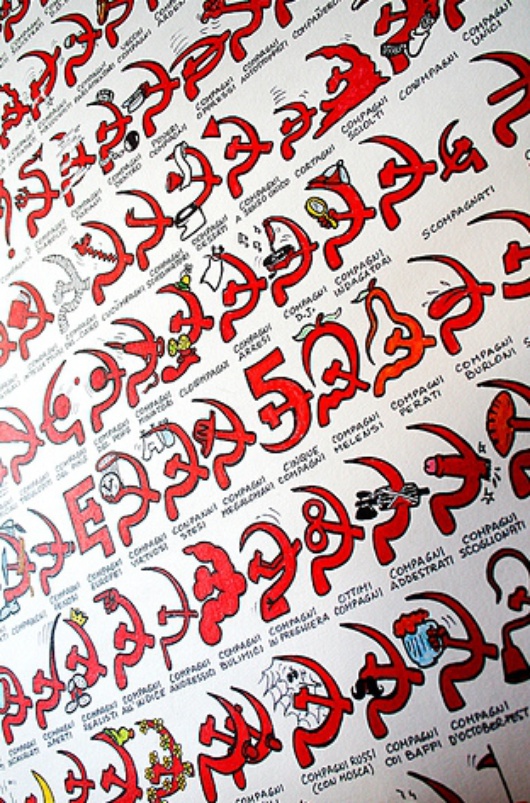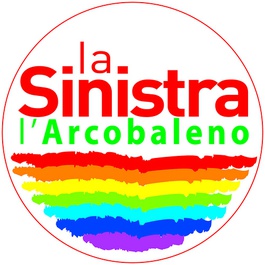
Italy's communist revival: return to the hammer and sickle?
Published on
Translation by:
Kate MartinIn preparation for the European elections in June 2009, the Italian communist parties are dusting off the old symbols (the hammer and sickle and the Bandiera Rossa or ‘red flag song’), attending rallies and facing the usual internal disagreement between factions
In the light of the upcoming European elections in June 2009, the failure of recent policies and the threat of falling below a minimum 5% vote, the largest Italian communist party - the Rifondazione Comunista ('Communist Refoundation Party', hereon PRC) - has decided on a ‘new’ strategy to return to the past. In a careful balancing act between restoring old symbols like the hammer and sickle and the Bandiera Rossa (revolutionary song from the beginning of the twentieth century - ed) and managing tensions between certain members and the most left wing of the democratic party, there are renewed fears of further party divisions.
Communist pride
 On 12 October in Piazza della Bocca della Verità in Rome, the day after the ‘communist pride’ demonstration, everything was tinged with red. There were red flyers, red banners; PRC banners, the party for Italian communists, the democratic left, the socialists and the CGIL (‘general confederation of labour’, Italy’s largest trade union - ed).
On 12 October in Piazza della Bocca della Verità in Rome, the day after the ‘communist pride’ demonstration, everything was tinged with red. There were red flyers, red banners; PRC banners, the party for Italian communists, the democratic left, the socialists and the CGIL (‘general confederation of labour’, Italy’s largest trade union - ed).
Rome was paved with ideology. Paolo Ferrero, PRC secretary, sees this as a sign of what he calls a 'return to communist symbols and to the streets, a way of reaching out to disenchanted members of the electorate.' His views are contested by Nicola Vendola, governor for the region of Puglia. The former MP is leader of a strong current within the party, known as ‘vendolist’. This supports dialogue with the democratic party and is therefore more moderate. Ferrero defeated his ‘reformist’ opponent at congress by just two votes, showing that it is still possible to win by raising your fist in the air and singing Bandiera Rossa. On that day, the heads of the ‘largest’ communist party in Italy voted not for ‘reform’ - as the party’s name suggests - but for the ‘restoration’ of the left.
Bonding over a common hatred of Berlusconi
There are, however, other clear messages in the tattered remnants of the demonstration, in the flyers strewn this way and that by the wind: an internal battle is raging, dividing and complicating the Italian left due to the different movements, thoughts and positions of parties who cannot reach a 3% agreement between them. They just about manage to hold themselves together thanks to their mutual hatred of prime minister Silvio Berlusconi. They nearly always come together at protests, like the demonstration on 11 October against government policy, contesting school reforms announced by the minister for education, Mariastella Gelmini, the latest finance bill and the crusade against state employees led by minister Renato Brunetta.
 The parties are side by side, trying to build the best alliances they can, working out how to divide up and then reunite under a single banner in order to survive as representatives within the political institutions. Nobody said it works. In fact, a ‘radical’ collaboration bill called La Sinistra l'Arcobaleno (‘the rainbow of the left’) between the PRC, the greens, the Italian communists and the democratic left, resulted in the communists and the greens losing all their seats in parliament at the elections in April 2008.
The parties are side by side, trying to build the best alliances they can, working out how to divide up and then reunite under a single banner in order to survive as representatives within the political institutions. Nobody said it works. In fact, a ‘radical’ collaboration bill called La Sinistra l'Arcobaleno (‘the rainbow of the left’) between the PRC, the greens, the Italian communists and the democratic left, resulted in the communists and the greens losing all their seats in parliament at the elections in April 2008.
‘The party is still in real trouble, badly affected by a lack of interest from its supporters and under attack from the radical populism of Antonio Di Pietro (a former judge who founded a political party - ed) and comedian-cum-politican Beppe Grillo. PRC sees the European elections as a chance to get back in the game, but the situation could turn sour if a new bill to set a minimum 5% vote is passed by the Italian government (the current system has no cut off point or other limitations).
'The crisis of the Italian left is in line with what is happening all over Europe'
'If a 5% vote is not reached, the party in question cannot have representatives selected at Strasbourg,’ explains Federico Geremicca from La Stampa daily newspaper. ‘When considering PRC (and even the democratic party) it is important to note how the crisis of the Italian left is in line with what is happening all over Europe, from the British labour party to Scandinavian social democracy, to French and Spanish socialism. Reformist forces are in crisis over disagreement and policies. After attentively followed the American elections, many people have seen Obama’s victory as an opportunity to reverse current trends and open a new chapter in politics.’
Today, in a political climate where old ideas are being given a fresh start, communist propaganda is everywhere, a common denominator for all leftwing and communist parties, from the PRC to the democratic left (former members of the democratic left joined Margherita to become the democratic party), to socialists and the reds, followers of the former foreign minister Massimo D’Alema from the democratic party. Together, they flow determinedly against the current.
It is too early to tell, however, if beneath the layers of Italian communism, the red undercurrent is an emotional response to the nostalgic notes of Bandiera Rossa or the philanthropic piety brought on by the image of a bald man who insists on using a comb.
Translated from Restaurazione comunista italiana: ritornano falce e martello?



